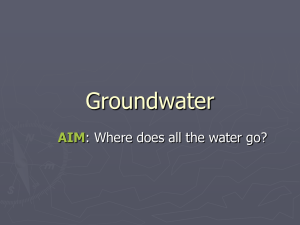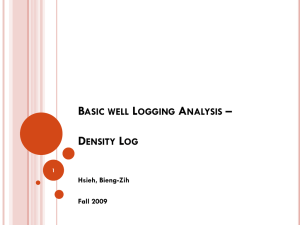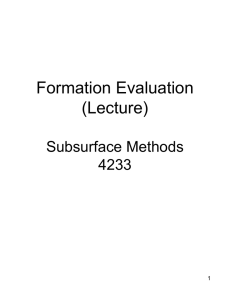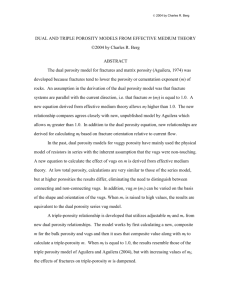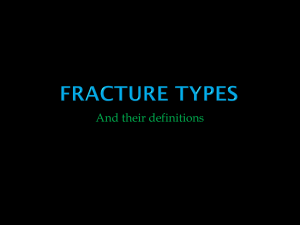Role of “in situ” k and hydraulically induced fractures in
advertisement
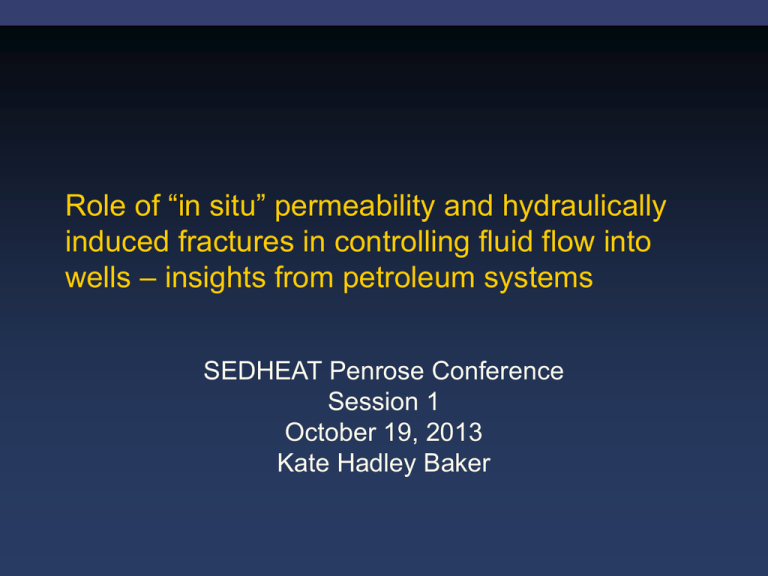
Role of “in situ” permeability and hydraulically induced fractures in controlling fluid flow into wells – insights from petroleum systems SEDHEAT Penrose Conference Session 1 October 19, 2013 Kate Hadley Baker Outline • What we think we know • • Recent models of how preexisting natural fractures affect or interact with fluid injection intended to induce hydraulic fractures or open existing ones to extract heat Anisotropy is not your friend What we don’t know • Matrix porosity must provide “storage” Matrix porosity decreases with depth; fracture porosity may or may not decrease with depth in the same way Naturally fractured producing horizons can be divided into 3 types Existing tools/methods to identify fractures and assess their relative flow contribution Flow anisotropy/heterogeneity is probably the norm Actual DFN at site x. Flow velocities and movement directions in the recharging brine reservoir beyond the well-field extent … and what else Summary from petroleum systems and thoughts on previous requests Previous “requests” Insights from petroleum systems • • Characterize and understand existing energy systems and their limitations Porosity has to provide the massively connected storage 30-50 kbd average for the life of well is a big ask Anisotropy is not your friend Understand risks and stressors associated with SEDHEAT Water utilization competition Potable/agricultural-use aquifer contamination, including waste water disposal & primary production system leaks Induced Seismicity Air quality, noise, light, fugitive heat, truck traffic… Previous “requests” Insights from petroleum systems – Forever Challenges • Cost Reduction • • Costs are front-end loaded – cheaper HT drilling would be a real boon • Less expensive, greener water treatment/disposal options Subsurface Imaging/Characterization Data improvement • Potable aquifer characterization for baseline studies • In situ stress regimes to understand fracture orientation • Can any of these be prospectively useful, or must each be done site-specifically? Science improvement • Subsurface imaging • Pre-drill brine salinity prediction • What geologic conditions preserve/create hi k,Φ at great depth in sedimentary rocks? • Pathway preservation in the presence of circulating fluids • Engineered stimulation networks • “Recovery factor” – total thermal extraction / heat transfer rate Matrix porosity must provide “storage” Fracture porosity is always very small Nelson, R.A. (1981) Geologic Analysis of Naturally Occurring Fractured Reservoirs (2nd ed., Butterworth-Heinemann) Matrix porosity decreases with depth Significant matrix porosity can persist at depths to 7 km. There is not much data below this. Red lines indicate P10, P50, and P90 for offshore GOM sandstone data points shown. Green lines are P10 and P50 trends for worldwide sandstone data (Ehrenberg and Nadeau, 2005). Blue line is average trend of onshore Texas lower Tertiary sandstones (Loucks et al., 1984). Porosity (%) Figure 6. from Ehrenberg et al (2008) A megascale view of reservoir quality in producing sandstones from the offshore Gulf of Mexico AAPG Bull, p145-164 Matrix porosity decreases with depth Brittle-ductile transition exists for all rocks Paterson and Wong (2005) Experimental Rock Deformation — The Brittle Field ISBN: 978-3-540-24023-5 Matrix porosity decreases with depth Brittle-ductile transition depends on lithology • e.g. All carbonates are not created equal Matrix porosity decreases with depth Chemical reactions play a significant role • Most reduce porosity by cementation or pressure solution SEM Photo from Maast et al (2011) Diagenetic controls on reservoir quality in Middle to Upper Jurassic sandstones in the South Viking Graben, North Sea AAPG Bull, 95, 1937– 1958. Photomicrograph from Ajdukiewicz et al. (2010) Prediction of deep reservoir quality using early diagenetic process models in the Jurassic Norphlet Formation, Gulf of Mexico AAPG Bull, 94, 1189–1227. SEM Photo from Taylor et al. (2010) Sandstone diagenesis and reservoir quality prediction: Models, myths, and reality AAPG Bull, 94, 1093–1132. Cement inhibitors: • Chlorite coats(√) • Early HC charge(?) • Some reactions create or enhance porosity Dolomitization of limestone(√) most commonly cited as significant Fracture porosity may or may not increase with depth in the same way Different time-evolution of fluid pressure and chemistry in fractures vs matrix porosity Tectonic controls on fracturing Rock strength/brittleness Structural curvature – f(t) Proximity to faults Strain rate – f(t) Bed thickness Fracture intensity cross-plot derived from core observations by Tilden and Harrison for two fractured reservoirs in Lost Soldier Field, WY. Fig 3-19 from Nelson (2001) Geologic Analysis of Naturally Fractured Reservoirs, Gulf Professional Publishing Naturally fractured producing horizons can be divided into 3 types Omnia Gallia in tres partes divisa est • • • Fractures provide both storage and the conduit to the well. Fractures enable economic production rates by augmenting matrix flow rates (dual porosity system) Fractures, while present, are insignificant to system performance because the matrix porosity and permeability is sufficiently large Fractures may enable – or be essential to – economic production rates 30-50 kbd is a big ask • In 2009, 5 of BP's 15 most prolific wells were located in Azerbaijan. Of the oil wells in that lot, 5 were at ACG. Assuming half of the produced fluid is oil, then the overall average fluid rate for the various field areas in ACG the year before field production peaked, with pressure support in place, was: Area # Oilwells Oil b/d Avg rate, kbd West Azeri 14 275,200 39.3 East Azeri 9 139,400 31.0 Central Azeri 13 185,800 28.6 DW Gunashli 9 116,000 25.8 Chirag 13 105,300 16.2 Fractures may enable – or be essential to – economic production rates 30-50 kbd is a big ask • The highest flow rate for a single well in the Gulf of Mexico as of 2010 was 46,467 bopd based on the daily average of the peak month of production. • There is no historical precedent for a single well producing more than 100,000 bopd. Fracture Identification and Flow Contribution Assessment Tools • Drilling Records holidays, kicks, losses, minor changes in mud chemistry • Openhole logs FMI, televiewer, caliper and others evidence fracture prevalence and geometry, but not flow contribution • Core • Having multiple sources of information is helpful Some tools may over-estimate fracturing; others under-estimate it Michael Gross, T.C. Lukas, and Peter Schwans (2009), AAPG Search and Discovery Article #20080 Openhole Records: Indicate or Identify Existing Tools/Relative Flow Contribution Assessment Cased or Openhole Flow Assessment • Direct Measurement Spinner surveys Distributed Temperature Surveys • Tracer Test Interpretation Where’s Pete Rose? • Pressure Transient Analysis Where’s Derek Elsworth? Pic of fractures or big flow zone on DTS or spinner Existing Tools/Relative Flow Contribution Assessment Pressure Transient Analysis • Seeks to interpret system pressure-time response in terms of models of fractured matrix systems of varying complexity Schematic Horner plot for a build-up test in a naturally fractured reservoir Flow periods for a well in a naturally fractured reservoir Figs 3 and 18 from: Cinco-Ley and Samaniego (1982) SPE 11026, Pressure Transient Analysis for Naturally Fractured Reservoirs Flow anisotropy is not your friend Permeability anisotropy is likely common In situ “discovery” flow anisotropy arises from depositional, diagenetic and mechanical geometries • Depositional – sediments are layered; many • • • are channelized Diagenetic Fractures – orientation controlled by stress orientation history; open fracture direction controlled by present-day stress orientation Faulting, folding, and other structural features, e.g. unconformities, dikes… NASA Earth from Space Photo #: ISS025E-5504 Sep. 2010, KAZAKHSTAN Stearns & Friedman (1972) Fig. 14 model of fractures associated with folding. In both, σ2 is inferred normal to bedding and σmax and σmin are bedding-parallel.

